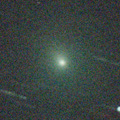
|
Now it is very bright as 6.6 mag (Nov. 11, Chris Wyatt). It will approach to Earth down to 0.08 a.u. in December, and it is expected to brighten up to 3 mag. In the Northern Hemisphere, it locates low until November, but it stays observable in excellent condition after December. In the Southern Hemisphere, it is observable in good condition until mid December when it brightens up to 3 mag. But it becomes unobservable after that.
Date(TT) R.A. (2000) Decl. Delta r Elong. m1 Best Time(A, h)
Nov. 10 2 2.73 -32 40.4 0.225 1.145 128 7.0 22:45 ( 0, 22)
Nov. 17 2 7.78 -30 54.6 0.189 1.112 126 6.2 22:22 ( 0, 24)
|
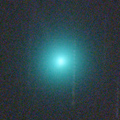
|
New bright comet discovered by three amateur comet hunters. Now it is very bright as 7.5 mag (Nov. 11, Charles Morris). In the Northern Hemisphere, it is observable in the morning low sky until mid November. It can be observable in the extreme low sky until around Nov. 24. It can be observable in the extreme low sky in the evening at 5.5-7 mag from around Dec. 5 to around Dec. 15. In the Southern Hemisphere, it is not observable now. But it will appear in the morning sky at 14 mag in February, then it stays observable in good condition while the comet will be fading gradually.
Date(TT) R.A. (2000) Decl. Delta r Elong. m1 Best Time(A, h)
Nov. 10 12 30.21 -1 54.4 1.105 0.718 39 8.8 5:02 (288, 21)
Nov. 17 13 20.56 -0 59.3 0.865 0.584 35 7.4 5:08 (285, 18)
|
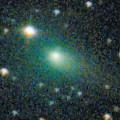
|
Now it is bright as 9.3 mag (Nov. 11, Marco Goiato). It stays 9-10 mag until January. In the Northern Hemisphere, it stays observable in good condition for a long time until it fades out. In the Southern Hemispehre, it is observable in good condition until autumn, but it will be low in winter.
Date(TT) R.A. (2000) Decl. Delta r Elong. m1 Best Time(A, h)
Nov. 10 7 30.18 21 12.2 0.878 1.589 116 9.2 4:15 ( 0, 76)
Nov. 17 7 44.47 23 27.5 0.841 1.590 120 9.2 4:01 ( 0, 78)
|

|
It brightened up to 6.8 mag in September (Sept. 17, Seiichi Yoshida). Now it is fading faster than this ephemeris. It has already faded down to 11.1 mag (Nov. 11, Marco Goiato). It is observable in excellent condition in the Southern Hemisphere. It locates low after this in the Northern Hemisphere.
Date(TT) R.A. (2000) Decl. Delta r Elong. m1 Best Time(A, h)
Nov. 10 7 24.85 -32 41.5 0.722 1.318 99 9.9 4:09 ( 0, 22)
Nov. 17 7 21.35 -35 25.8 0.768 1.377 102 10.3 3:39 ( 0, 20)
|

|
It brightened up to 7.7 mag in June (June 19, Juan Jose Gonzalez). Now it is fading. But it is still bright as 10.7 mag (Nov. 11, Chris Wyatt). In the Southern Hemisphere, it stays observable in good condition for a long time until the comet will fade out. In the Northern Hemisphere, it is not observable for a long time until autumn in 2019 when the comet fades out down to 16 mag.
Date(TT) R.A. (2000) Decl. Delta r Elong. m1 Best Time(A, h)
Nov. 10 15 2.27 -70 39.2 2.901 2.448 53 10.6 18:25 ( 24,-36)
Nov. 17 15 13.10 -72 39.8 2.934 2.483 53 10.8 5:08 (339,-35)
|

|
Now it is very bright as 9.2 mag (Nov. 9, Juan Jose Gonzalez). It is observable in excellent condition in the Northern Hemisphere. It stays low in the Southern Hemisphere.
Date(TT) R.A. (2000) Decl. Delta r Elong. m1 Best Time(A, h)
Nov. 10 1 0.42 36 46.8 0.455 1.395 147 10.7 21:43 (180, 88)
Nov. 17 1 12.74 36 17.4 0.470 1.402 145 10.8 21:28 (180, 89)
|
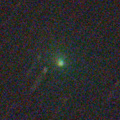
|
Now it is very bright as 10.8 mag (Oct. 12, Paul Camilleri). It stays at 10-11 mag until winter. In the Northern Hemisphere, it stays observable for a long time until it fades out. But it stays extremely low. It will never be observable again in the Southern Hemisphere.
Date(TT) R.A. (2000) Decl. Delta r Elong. m1 Best Time(A, h)
Nov. 10 16 39.58 3 48.3 2.491 1.737 32 11.0 18:25 ( 85, 14)
Nov. 17 16 55.34 5 26.5 2.474 1.724 32 10.9 18:21 ( 87, 13)
|

|
Now it is 11.9 mag (Nov. 3, Seiichi Yoshida). It stays 12 mag for a long time until spring.
Date(TT) R.A. (2000) Decl. Delta r Elong. m1 Best Time(A, h)
Nov. 10 8 48.38 -0 48.2 2.712 2.926 92 12.2 5:02 (347, 53)
Nov. 17 8 41.80 -3 17.8 2.623 2.956 99 12.2 4:59 ( 0, 52)
|

|
Now it is 10.3 mag (Nov. 9, Juan Jose Gonzalez). It will be fading slowly after this. In the Northern Hemisphere, it will be getting higher gradually after this, and it will be observable in good condition. In the Southern Hemisphere, it is not observable until summer in 2019.
Date(TT) R.A. (2000) Decl. Delta r Elong. m1 Best Time(A, h)
Nov. 10 13 56.50 42 37.2 3.592 3.235 61 12.4 5:02 (235, 26)
Nov. 17 14 10.54 42 0.8 3.598 3.278 63 12.5 5:08 (237, 29)
|

|
Now it is bright as 12.9 mag (Nov. 11, Chris Wyatt). Diffuse.
Date(TT) R.A. (2000) Decl. Delta r Elong. m1 Best Time(A, h)
Nov. 10 22 44.63 -1 0.2 5.284 5.769 114 13.3 19:27 ( 0, 54)
Nov. 17 22 44.99 -1 1.7 5.389 5.769 107 13.4 19:00 ( 0, 54)
|
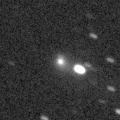
|
Now it is 13.5 mag (Nov. 1, Paul Camilleri). It stays at 12-13 mag for a long time until autumn in 2019.
Date(TT) R.A. (2000) Decl. Delta r Elong. m1 Best Time(A, h)
Nov. 10 21 38.40 -8 58.5 1.986 2.319 96 13.4 18:25 ( 1, 46)
Nov. 17 21 45.77 -8 45.9 2.046 2.293 91 13.4 18:21 ( 7, 46)
|

|
Now it is 13.8 mag (Nov. 1, Paul Camilleri). It will brighten up to 10-11 mag in autumn in 2019. It stays observable in good condition for a while in the Southern Hemisphere. In the Northern Hemisphere, it stays extremely low for a long time.
Date(TT) R.A. (2000) Decl. Delta r Elong. m1 Best Time(A, h)
Nov. 10 1 46.71 -45 23.4 4.118 4.632 115 13.7 22:28 ( 0, 10)
Nov. 17 1 37.62 -44 21.7 4.124 4.587 111 13.7 21:51 ( 0, 11)
|

|
It must have brightened up to 13 mag in October. But it is not observable at all.
Date(TT) R.A. (2000) Decl. Delta r Elong. m1 Best Time(A, h)
Nov. 10 16 2.05 -12 0.5 2.118 1.197 15 14.2 18:25 ( 77, -3)
Nov. 17 16 29.71 -12 6.9 2.154 1.237 16 15.2 18:21 ( 76, -2)
|

|
Now it is 14.0 mag (Oct. 7, Seiichi Yoshida). It stays 13-14 mag until summer in 2019. It is not observable now in the Southern Hemisphere. It will be unobservable in November also in the Northeren Hemisphere.
Date(TT) R.A. (2000) Decl. Delta r Elong. m1 Best Time(A, h)
Nov. 10 16 36.85 -0 10.3 4.146 3.318 29 14.3 18:25 ( 82, 11)
Nov. 17 16 41.00 -1 45.4 4.177 3.305 24 14.3 18:21 ( 83, 6)
|

|
Now it is 14.0 mag (Nov. 3, Seiichi Yoshida). It stays at 14 mag until winter. It is observable in excellent condition in the Northern Hemisphere. In the Southern Hemisphere, it is not observable until summer in 2019.
Date(TT) R.A. (2000) Decl. Delta r Elong. m1 Best Time(A, h)
Nov. 10 9 28.67 73 25.3 1.458 1.953 104 14.4 5:02 (188, 51)
Nov. 17 10 12.20 74 49.9 1.450 1.959 105 14.3 5:08 (188, 49)
|

|
Now it is 14.3 mag (Aug. 17, Ken-ichi Kadota). It will be observable at 13-14 mag for a long time from 2017 to 2018. It is observable in excellent condition until spring in the Northern Hemispehre. In the Southern Hemisphere, it will be hardly observable after this.
Date(TT) R.A. (2000) Decl. Delta r Elong. m1 Best Time(A, h)
Nov. 10 12 1.19 34 49.2 4.684 4.390 66 14.4 5:02 (253, 45)
Nov. 17 12 0.68 35 6.6 4.609 4.422 72 14.4 5:08 (256, 52)
|
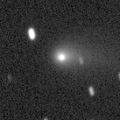
|
Now it is 13.9 mag (Nov. 8, Chris Wyatt). It will be fading after this. It stays observable in excellent condition for a while in the Southern Hemisphere. It locates somewhat low in the Northern Hemisphere.
Date(TT) R.A. (2000) Decl. Delta r Elong. m1 Best Time(A, h)
Nov. 10 22 52.57 -23 53.4 1.609 2.125 107 14.5 19:35 ( 0, 31)
Nov. 17 23 0.23 -22 35.5 1.697 2.143 102 14.7 19:16 ( 0, 33)
|

|
Now it is 15.4 mag (Oct. 7, iTelescope Observatory, Siding Spring). It locates low. But it brightens up to 14.5 mag from October to November.
Date(TT) R.A. (2000) Decl. Delta r Elong. m1 Best Time(A, h)
Nov. 10 18 15.23 -26 54.1 1.130 0.842 46 14.5 18:25 ( 45, 12)
Nov. 17 18 59.07 -26 56.0 1.086 0.865 48 14.7 18:21 ( 42, 14)
|
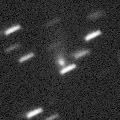
|
It brightened up to 8.7 mag in July (July 18, Marco Goiato). Then it faded down to 12.3 mag in August (Aug. 29, Chris Wyatt). Now it is not observable. It will appear in the morning sky in late December.
Date(TT) R.A. (2000) Decl. Delta r Elong. m1 Best Time(A, h)
Nov. 10 14 56.51 -24 51.4 3.047 2.070 7 14.6 5:02 (286,-22)
Nov. 17 15 7.71 -24 18.1 3.139 2.162 7 14.8 5:08 (288,-17)
|
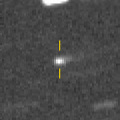
|
Now it is 15.6 mag (Oct. 13, D. Buczynski). Brightening very rapidly. It will brighten up to 14 mag from January to February, and it is expected to be observable in excellent condition.
Date(TT) R.A. (2000) Decl. Delta r Elong. m1 Best Time(A, h)
Nov. 10 9 37.74 12 45.5 1.415 1.652 84 15.0 5:02 (316, 61)
Nov. 17 9 54.19 10 59.1 1.354 1.640 87 14.7 5:08 (325, 62)
|
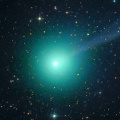
|
It brightened rapidly in outburst up to 6.9 mag (July 19, Maik Meyer). Then it faded down to 9.3 mag (Aug. 2, Katsumi Yoshimoto). It approached to Sun down to 0.2 a.u. in August, and it was expected to brighten up to 3 mag. However, it must have been already disintegrated. In the Northern Hemisphere, it is appearing in the morning sky. But it will be too faint to observe.
Date(TT) R.A. (2000) Decl. Delta r Elong. m1 Best Time(A, h)
Nov. 10 13 15.79 22 46.4 2.491 1.957 47 14.9 5:02 (259, 25)
Nov. 17 13 24.91 24 17.3 2.518 2.070 52 15.2 5:08 (260, 31)
|

|
Now it is 14.5 mag (Aug. 16, P. Camilleri, H. Williams). It stays 15 mag from 2018 to 2019, and it will be observable for a long time in the Southern Hemisphere. In the Northern Hemisphere, it will never be observable again.
Date(TT) R.A. (2000) Decl. Delta r Elong. m1 Best Time(A, h)
Nov. 10 16 33.79 -68 38.7 4.494 3.989 53 15.0 18:25 ( 24,-28)
Nov. 17 17 0.45 -68 40.3 4.512 3.979 51 15.0 18:21 ( 23,-27)
|

|
It approached to Earth down to 0.3 a.u., and brightened up to 8.3 mag in July (July 22, Juan Jose Gonzalez). Now it is fading. It has faded down to 13.2 mag in September (Sept. 24, Thomas Lehmann). Now it is not observable. It will appear in the morning sky again in December in the Northern Hemisphere, or in January in the Southern Hemisphere.
Date(TT) R.A. (2000) Decl. Delta r Elong. m1 Best Time(A, h)
Nov. 10 15 18.37 -5 33.8 2.901 1.945 12 15.2 18:25 ( 89, -8)
Nov. 17 15 20.63 -5 13.9 2.962 2.015 13 15.4 5:08 (270, -9)
|

|
Now it is 16.5 mag (Oct. 4, I. Dulevich, S. Plaksa). It will brighten up to 13-14 mag in winter, and it will be observable in excellent condition. It locates low in the Southern Hemisphere.
Date(TT) R.A. (2000) Decl. Delta r Elong. m1 Best Time(A, h)
Nov. 10 10 6.74 28 1.7 2.111 2.234 83 15.4 5:02 (279, 66)
Nov. 17 10 19.70 27 45.4 2.022 2.218 87 15.3 5:08 (285, 70)
|
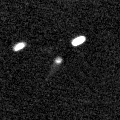
|
Now it is 15.8 mag (Oct. 13, S. Shurpakov). It will brighten up to 15 mag in winter. It is observable in excellent condition in the Northern Hemisphere. It is not observable at all in the Southern Hemisphere.
Date(TT) R.A. (2000) Decl. Delta r Elong. m1 Best Time(A, h)
Nov. 10 11 18.49 46 8.4 3.352 3.332 80 15.9 5:02 (238, 54)
Nov. 17 11 19.37 48 26.7 3.222 3.321 87 15.8 5:08 (233, 60)
|

|
Now it is 16.0 mag (Oct. 11, C. Bell). It is expected to brighten up to 7-8 mag in 2020. In 2018, it will be observable at 15-16 mag in good condition from autum to winter.
Date(TT) R.A. (2000) Decl. Delta r Elong. m1 Best Time(A, h)
Nov. 10 3 38.90 -6 2.0 5.191 6.103 154 15.9 0:25 ( 0, 49)
Nov. 17 3 34.24 -6 2.4 5.133 6.044 155 15.9 23:48 ( 0, 49)
|
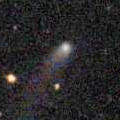
|
It brightened up to 14.7 mag in early 2018 (Jan. 25, Catalina Sky Survey). Now it is fading slowly. Now it is 16.1 mag (Oct. 10, I. Dulevich, S. Plaksa). In the Northern Hemisphere, it stays observable in good condition for a long time until the comet fades out. It is never observable again in the Southern Hemisphere.
Date(TT) R.A. (2000) Decl. Delta r Elong. m1 Best Time(A, h)
Nov. 10 8 16.86 63 40.8 5.517 5.928 109 16.5 5:02 (180, 61)
Nov. 17 8 10.61 65 14.4 5.463 5.950 115 16.5 4:29 (180, 60)
|
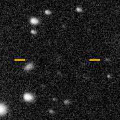
|
Now it is 17.0 mag (Oct. 12, C. Bell). It is observable at 16.5 mag in good condition from autumn to winter. It locates somewhat low in the Southern Hemisphere.
Date(TT) R.A. (2000) Decl. Delta r Elong. m1 Best Time(A, h)
Nov. 10 8 24.65 26 0.4 1.941 2.395 104 16.6 5:02 (350, 81)
Nov. 17 8 29.96 25 35.2 1.871 2.405 110 16.6 4:47 ( 0, 81)
|

|
It brightened up to 7 mag from May to June in 2017. Now it is fading. It has already faded down to 16.0 mag (Sept. 30, J. Drummond). In the Southern Hemisphere, it stays observable for a long time after this. It will never be observable again in the Northern Hemisphere.
Date(TT) R.A. (2000) Decl. Delta r Elong. m1 Best Time(A, h)
Nov. 10 1 1.84 -53 2.3 5.533 5.876 105 16.6 21:43 ( 0, 2)
Nov. 17 0 57.85 -52 17.4 5.655 5.936 101 16.7 21:12 ( 0, 3)
|
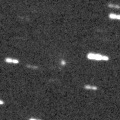
|
It stays 15 mag for a long time in 2019. In the Southern Hemisphere, it is observable in excellent condition. In the Northern Hemisphere, it is observable in low sky until early January, but it will be unobservable after that.
Date(TT) R.A. (2000) Decl. Delta r Elong. m1 Best Time(A, h)
Nov. 10 11 19.88 -23 43.3 4.230 3.697 51 16.8 5:02 (317, 17)
Nov. 17 11 23.14 -25 45.4 4.114 3.663 56 16.7 5:08 (324, 19)
|

|
Now it is 17.0 mag (Oct. 12, D. Buczynski). It stays 16-17 mag for a long time until 2020. It is observable in good condition in the Northern Hemisphere. It is not observable at all in the Southern Hemisphere.
Date(TT) R.A. (2000) Decl. Delta r Elong. m1 Best Time(A, h)
Nov. 10 11 21.94 68 17.2 8.347 8.470 93 16.7 5:02 (204, 48)
Nov. 17 11 29.20 68 36.3 8.285 8.467 97 16.7 5:08 (201, 50)
|

|
Now it is 16.4 mag (Sept. 29, Catalina Sky Survey). It is observable in good condition in the Southern Hemisphere. It locates somewhat low in the Northern Hemisphere.
Date(TT) R.A. (2000) Decl. Delta r Elong. m1 Best Time(A, h)
Nov. 10 22 48.28 -18 20.2 2.988 3.439 108 16.8 19:31 ( 0, 37)
Nov. 17 22 50.31 -17 42.9 3.100 3.454 102 16.9 19:05 ( 0, 37)
|
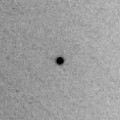
|
Now it is 16.2 mag (Sept. 13, ATLAS-MLO, Mauna Loa). It stays 16 mag for a while. In the Northern Hemisphere, it stays observable in good condition after this until it fades out. It is not observable in the Southern Hemisphere. Its cometary activity was observed on Mar. 26 (M. Mommert, D. Polishook, N. Moskovitz).
Date(TT) R.A. (2000) Decl. Delta r Elong. m1 Best Time(A, h)
Nov. 10 1 14.24 53 13.6 1.637 2.467 138 16.9 21:56 (180, 72)
Nov. 17 1 5.50 52 10.9 1.712 2.524 136 17.0 21:20 (180, 73)
|
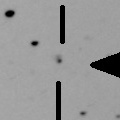
|
Asteroid, but it brightened rapidly. Now it is 16.4 mag (Oct. 9, P. Camilleri, J. Oey).
Date(TT) R.A. (2000) Decl. Delta r Elong. m1 Best Time(A, h)
Nov. 10 22 22.10 -44 50.8 6.635 6.741 91 17.0 19:04 ( 0, 10)
Nov. 17 22 17.86 -44 19.5 6.732 6.727 85 17.0 18:33 ( 0, 11)
|
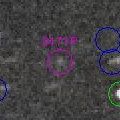
|
Now it is 17.9 mag (Oct. 10, Catalina Sky Survey). It will brighten rapidly. It was expected to be observable at 15.5 mag in good condition in winter. But actually, it is fainter than expected.
Date(TT) R.A. (2000) Decl. Delta r Elong. m1 Best Time(A, h)
Nov. 10 4 59.46 -7 21.4 0.987 1.867 141 17.2 1:45 ( 0, 48)
Nov. 17 4 56.16 -6 40.5 0.942 1.848 146 17.0 1:14 ( 0, 48)
|
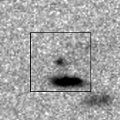
|
Now it is 17.5 mag (Oct. 10, D. Buczynski). It is observable at 17 mag in good condition in winter. It locates low in the Southern Hemisphere.
Date(TT) R.A. (2000) Decl. Delta r Elong. m1 Best Time(A, h)
Nov. 10 10 32.69 20 2.4 2.294 2.254 75 17.1 5:02 (288, 57)
Nov. 17 10 42.55 20 1.5 2.248 2.293 79 17.1 5:08 (294, 61)
|

|
First return of a new periodic comet which brightened up to 16.5 mag in 2005. Now it is 16.3 mag (Oct. 15, S. Shurpakov). It will be observable at 17 mag in good condition in autumn. It locates low in the Southern Hemisphere.
Date(TT) R.A. (2000) Decl. Delta r Elong. m1 Best Time(A, h)
Nov. 10 1 48.82 29 38.9 1.180 2.136 159 17.2 22:31 ( 0, 85)
Nov. 17 1 48.29 28 2.2 1.214 2.153 155 17.3 22:03 ( 0, 83)
|
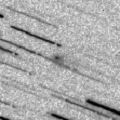
|
First return of a new periodic comet which brightened up to 17.5 mag in 2010. Now it is 18.1 mag (Oct. 13, J.-F. Soulier). It was expected to brighten up to 16.5 mag from November to December. But actually, it is a bit fainter than expected. It is observable in excellent condition in the Northern Hemisphere. It locates low in the Southern Hemisphere.
Date(TT) R.A. (2000) Decl. Delta r Elong. m1 Best Time(A, h)
Nov. 10 6 13.35 30 48.1 1.151 1.971 133 17.3 2:59 ( 0, 86)
Nov. 17 6 14.71 31 57.1 1.115 1.980 140 17.2 2:32 ( 0, 87)
|

|
Now it is 17.4 mag (June 6, Slooh.com Canary Islands Observatory). Fading slowly. It stays observable at 17 mag in good condition until summer in 2019.
Date(TT) R.A. (2000) Decl. Delta r Elong. m1 Best Time(A, h)
Nov. 10 11 31.13 5 50.1 10.360 9.844 56 17.3 5:02 (292, 37)
Nov. 17 11 33.58 5 45.2 10.268 9.854 62 17.2 5:08 (299, 42)
|

|
Now it is 18.1 mag (Oct. 13, W. Hasubick). It was observed at 17 mag in last winter. It will be observable in good condition at 17.5 mag also in this winter.
Date(TT) R.A. (2000) Decl. Delta r Elong. m1 Best Time(A, h)
Nov. 10 5 24.46 7 15.8 7.201 8.016 143 17.4 2:10 ( 0, 62)
Nov. 17 5 19.44 6 49.2 7.149 8.023 150 17.4 1:37 ( 0, 62)
|
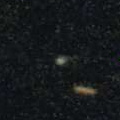
|
It brightened very rapidly. Now it is 16.7 mag (Oct. 12, Purple Mountain Observatory, XuYi Station). It seems to stay bright for a while.
Date(TT) R.A. (2000) Decl. Delta r Elong. m1 Best Time(A, h)
Nov. 10 23 56.91 -11 6.4 0.995 1.776 126 17.4 20:39 ( 0, 44)
Nov. 17 0 1.28 -9 16.8 1.054 1.786 121 17.6 20:16 ( 0, 46)
|
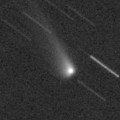
|
Now it is 17.0 mag (Oct. 12, ATLAS-MLO, Mauna Loa). Fading now. It stays observable in good condition for a long time after this in the Southern Hemisphere. It stays low in the Northern Hemisphere.
Date(TT) R.A. (2000) Decl. Delta r Elong. m1 Best Time(A, h)
Nov. 10 22 45.77 -39 52.4 4.805 5.041 98 17.4 19:28 ( 0, 15)
Nov. 17 22 41.32 -39 53.0 4.952 5.071 91 17.5 18:56 ( 0, 15)
|

|
Now it is 17.0 mag (Oct. 4, A. Diepvens). It will be fading gradually after this, and it will be fainter than 18 mag in winter. In the Northern Hemisphere, it stays observable in good condition for a long time. In the Southern Hemisphere, it will never be observable again.
Date(TT) R.A. (2000) Decl. Delta r Elong. m1 Best Time(A, h)
Nov. 10 22 38.30 72 16.7 7.372 7.822 113 17.5 19:20 (180, 53)
Nov. 17 22 40.74 71 20.1 7.400 7.849 113 17.5 18:55 (180, 54)
|

|
Now it is 17.5 mag (Oct. 6, K. Hills). It was observed at 18 mag in last winter. It will be observable in good condition at 17.5 mag also in this winter.
Date(TT) R.A. (2000) Decl. Delta r Elong. m1 Best Time(A, h)
Nov. 10 7 27.22 5 31.7 2.376 2.917 113 17.5 4:12 ( 0, 61)
Nov. 17 7 28.32 4 46.5 2.312 2.931 119 17.5 3:46 ( 0, 60)
|
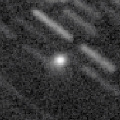
|
It brightened up to 16 mag in 2018 spring. Now it is fading. It stays observable in good condition until March when the comet will be fainter than 18 mag.
Date(TT) R.A. (2000) Decl. Delta r Elong. m1 Best Time(A, h)
Nov. 10 10 40.35 2 38.9 3.666 3.400 66 17.5 5:02 (306, 44)
Nov. 17 10 44.95 3 20.0 3.598 3.441 72 17.5 5:08 (314, 49)
|

|
Now it is 18.1 mag (Oct. 15, Kunihiro Shima). Although it is around the aphelion, it is observable at 17.5 mag in November, in good condition in the Northern Hemisphere. It locates very low in the Southern Hemisphere.
Date(TT) R.A. (2000) Decl. Delta r Elong. m1 Best Time(A, h)
Nov. 10 3 5.33 39 38.1 1.442 2.386 157 17.6 23:46 (180, 85)
Nov. 17 2 46.77 38 14.0 1.428 2.377 158 17.5 23:00 (180, 87)
|
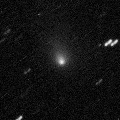
|
It brightened very rapidly up to 13.8 mag in August in 2017 (Aug. 22, Kunihiro Shima). Now it is 16.9 mag (Oct. 11, D. Buczynski). In the Northern Hemisphere, it stays observable in excellent condition after this. It will be observable also in the Southern Hemisphere in December, but it stays low.
Date(TT) R.A. (2000) Decl. Delta r Elong. m1 Best Time(A, h)
Nov. 10 10 32.25 29 7.4 2.519 2.528 79 17.6 5:02 (272, 61)
Nov. 17 10 42.40 29 25.5 2.462 2.555 83 17.6 5:08 (276, 66)
|

|
Peculiar asteroid moving along a cometary orbit. Now it is 17.2 mag (Sept. 9, M. Jaeger, et al.). It is observable at 17.5 mag in good condition in November. It locates somewhat low in the Southern Hemisphere.
Date(TT) R.A. (2000) Decl. Delta r Elong. m1 Best Time(A, h)
Nov. 10 3 37.40 24 31.3 2.131 3.108 168 17.8 0:23 ( 0, 80)
Nov. 17 3 33.51 23 47.2 2.114 3.100 174 17.6 23:47 ( 0, 79)
|
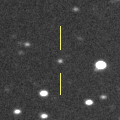
|
Now it is 16.6 mag (Oct. 7, Toshihiko Ikemura, Hirohisa Sato). It will be fading after this. It will be fainter than 18 mag in December.
Date(TT) R.A. (2000) Decl. Delta r Elong. m1 Best Time(A, h)
Nov. 10 21 57.83 -6 56.4 1.495 1.955 101 17.6 18:41 ( 0, 48)
Nov. 17 22 8.31 -6 25.2 1.553 1.946 97 17.7 18:24 ( 0, 49)
|

|
It brightened up to 12 mag from spring to summer. Now it is fading. It has already faded down to 17.1 mag (Oct. 8, Toshihiko Ikemura, Hirohisa Sato).
Date(TT) R.A. (2000) Decl. Delta r Elong. m1 Best Time(A, h)
Nov. 10 23 1.17 4 49.1 1.705 2.367 120 17.7 19:44 ( 0, 60)
Nov. 17 23 5.46 4 58.7 1.821 2.408 114 18.0 19:20 ( 0, 60)
|
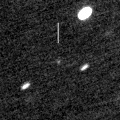
|
Now it is 17.9 mag (Oct. 8, W. Hasubick). It is observable at 17.5 mag until January, in good condition in the Northern Hemisphere. It locates very low in the Southern Hemisphere.
Date(TT) R.A. (2000) Decl. Delta r Elong. m1 Best Time(A, h)
Nov. 10 6 38.12 38 32.6 3.056 3.747 127 17.8 3:23 (180, 87)
Nov. 17 6 36.54 39 24.0 2.996 3.757 134 17.7 2:54 (180, 86)
|

|
Now it is 17.9 mag (Oct. 6, D. Buczynski). It will be fainter than 18 mag in December.
Date(TT) R.A. (2000) Decl. Delta r Elong. m1 Best Time(A, h)
Nov. 10 5 8.35 1 51.0 7.019 7.849 144 17.9 1:54 ( 0, 57)
Nov. 17 5 6.24 1 38.9 7.008 7.883 150 17.9 1:24 ( 0, 57)
|
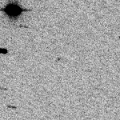
|
Return of a new periodic comet which brightened up to 17 mag in 2001. Now it is 19.2 mag (Oct. 12, K. Hills). It was predicted to brighten up to 17.5 mag from September to November. But actually, it is fainter than predicted by 2 mag.
Date(TT) R.A. (2000) Decl. Delta r Elong. m1 Best Time(A, h)
Nov. 10 1 31.31 -9 49.3 1.322 2.210 145 19.5 22:13 ( 0, 45)
Nov. 17 1 27.94 -8 25.9 1.370 2.218 139 19.6 21:42 ( 0, 47)
|
|
![]()
 C/2017 M4 ( ATLAS )
C/2017 M4 ( ATLAS ) (944) Hidalgo
(944) Hidalgo C/2015 O1 ( PanSTARRS )
C/2015 O1 ( PanSTARRS ) 48P/Johnson
48P/Johnson 300P/Catalina
300P/Catalina C/2017 T3 ( ATLAS )
C/2017 T3 ( ATLAS ) 60P/Tsuchinshan 2
60P/Tsuchinshan 2 C/2017 S3 ( PanSTARRS )
C/2017 S3 ( PanSTARRS ) C/2017 B3 ( LINEAR )
C/2017 B3 ( LINEAR ) C/2018 N1 ( NEOWISE )
C/2018 N1 ( NEOWISE ) 123P/West-Hartley
123P/West-Hartley C/2018 A3 ( ATLAS )
C/2018 A3 ( ATLAS ) C/2017 T2 ( PanSTARRS )
C/2017 T2 ( PanSTARRS ) C/2016 A1 ( PanSTARRS )
C/2016 A1 ( PanSTARRS ) 59P/Kearns-Kwee
59P/Kearns-Kwee C/2015 V2 ( Johnson )
C/2015 V2 ( Johnson ) C/2018 A6 ( Gibbs )
C/2018 A6 ( Gibbs ) C/2010 U3 ( Boattini )
C/2010 U3 ( Boattini ) 65P/Gunn
65P/Gunn (3552) Don Quixote
(3552) Don Quixote A/2017 U7
A/2017 U7 171P/Spahr
171P/Spahr 164P/Christensen
164P/Christensen 368P/2018 L3 ( NEAT )
368P/2018 L3 ( NEAT ) 369P/2018 P1 ( Hill )
369P/2018 P1 ( Hill ) C/2014 B1 ( Schwartz )
C/2014 B1 ( Schwartz ) C/2015 XY1 ( Lemmon )
C/2015 XY1 ( Lemmon ) P/2018 P3 ( PanSTARRS )
P/2018 P3 ( PanSTARRS ) C/2015 V1 ( PanSTARRS )
C/2015 V1 ( PanSTARRS ) C/2014 OE4 ( PanSTARRS )
C/2014 OE4 ( PanSTARRS ) 361P/2017 S4 ( Spacewatch )
361P/2017 S4 ( Spacewatch ) C/2018 E1 ( ATLAS )
C/2018 E1 ( ATLAS ) (3200) Phaethon
(3200) Phaethon 240P/NEAT
240P/NEAT (37117) Narcissus
(37117) Narcissus 137P/Shoemaker-Levy 2
137P/Shoemaker-Levy 2 37P/Forbes
37P/Forbes 159P/LONEOS
159P/LONEOS C/2011 KP36 ( Spacewatch )
C/2011 KP36 ( Spacewatch ) 371P/2018 R1 ( LINEAR-Skiff )
371P/2018 R1 ( LINEAR-Skiff )![]()















































